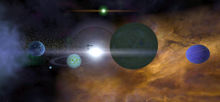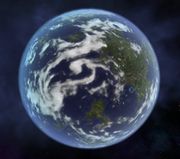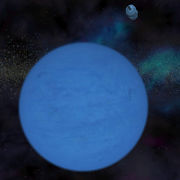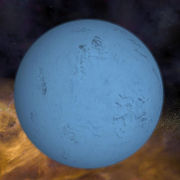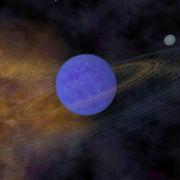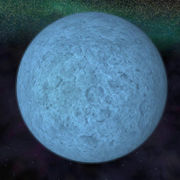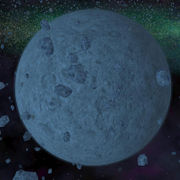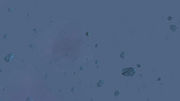Article possibly outdated (v4.86
)This article has not been verified to be up to date for the latest version of the Discovery mod. The last edit was made on 16.12.2012 (
DD/MM/YYYY). You may help by
updating it, often by using the
code generator.
Pennsylvania was originally settled by Zoners. Liberty's interest in the system gradually grew and House influence increased steadily until the System was heavily patrolled by the Liberty Police and Liberty Navy and was declared an independent system under Liberty protection. Thought dissent is prevalent among Zoners, any real resistance is beyond practical possibility.
System Overview
|
Astronomical Bodies
Stellar Objects
- Medium White Sun
- Green Dwarf Sun
- Planet Erie
- Planet Bruin
- Planet Dudley
- Planet Hallam
- Planet Sayre
- Planet Tyrone
- Planet Tremont
- Clarion
- Bradford
- Susquehanna
- Lansdale
- Appalachian Asteroid Field (multiple)
- Hallam Nebula
- Ralston Ice Field
- Meadville Ice Asteroid Field
- Scranton Asteroid Field
- Driftwood Ice Asteroid Field
- Wilkes-Barre Asteroid Field
|
Industrial Development
- Water (multiple)
- Helium
- Hydrocarbons
- Silver Ore
- Platinum Ore
|
Faction Presence
Lawful Factions
Corporations & Guilds
Unlawful Factions
|
[[Category: Liberty]]
Liberty]]
Planetary Bodies
Planet Erie
Location: E/4
- The green world of Erie was discovered in 679 A.S. Although the Pennsylvania system is located relatively close to New York, it took some time before Liberty became interested in its exploration. Erie was the only planet in the system with environment suitable for human colonization. Ecosystem of the planet was exceptionally rich with various land and water species, and in some way resembled Earth of Triassic period. At first, Liberty considered Erie to be suitable place of colonization for undesired elements from Manhattan. Later, however, it became known that some of microorganisms that inhabit Erie can infect humans, and numerous predators pose significant danger. Since Liberty was not ready to provide socially undesirable colonists with expensive medical supplies or weaponry to defend themselves, plans to colonize Erie have been delayed.|
- 10,921 km
- 6.67 x 10e25 kg
- Terrestrial
- -53°C to 65°C
- 10.54 km/sec
|
|
Planet Bruin
Location: D/3
- The large desert world of Bruin is one of the largest planets in Sirius that don't fall into the category of gas giants. Its thick atmosphere, however, doesn't contain nearly enough oxygene to support organic life, and strong gravitational field makes any terraforming attempts impossible right from the start.
- 14,717 km
- 10.69 x 10e24 kg
- Desert
- -71°C to 60°C
- 14.86 km/sec
|
|
Planet Dudley
Location: D/2
- A relatively small gas giant that proved to have a surprisingly compact silicon core. No traces of usable resources were found in the atmosphere.
- 7,820 km
- 2.54 x 10e24 kg
- N/A
- N/A
- 5.89 km/sec
|
|
Planet Hallam
Location: E/6
- An icy planet with thin cold atmosphere. Mineral resource deposists have recently been discovered on the surface, but neither Zoners nor Liberty companies showed interest in establishing a mining colony.
- 15,302 km
- 6.35 x 10e24 kg
- Ice
- -94°C to 15°C
- 10.12 km/sec
|
|
Planet Sayre
Location: C/5
- Sayre is a huge gas giant with beautiful purple atmosphere surrounded by an extensive system of rings that were considered to be the largest in all Sirius until the discovery of Planet Tonnerre. A single large moon named Bradford orbits the planet.
- 27,916 km
- 15.02 x 10e24 kg
- N/A
- N/A
- 16.45 km/sec
|
|
Planet Tyrone
Location: E/3
- A hot barren world with huge lava flows planetside that are visible even from space. High temperatures render any exploration attempts redundant.
- 12,826 km
- 9.11 x 10e24 kg
- Barren
- 112°C to 185°C
- 12.70 km/sec
|
|
Planet Tremont
Location: E/5
- While this yellow gas giant is much larger than Sayre in size, it has a much smaller ring system. Clarion is known to be the only large moon that orbits the planet.
- 35,576 km
- 12.87 x 10e24 kg
- N/A
- N/A
- 16.79 km/sec
|
|
Clarion
Location: F/5
- A rocky airless moon with no appreciable resources.
- 6,000 km
- 3.38 x 10e24 kg
- Barren
- -20°C to 56°C
- 4.21 km/sec
|
|
Bradford
Location: C/5
- A cold lifeless moon on the outskirts of Pennsylvania system. It has a small ring system of its own, comprised of elements dragged away from the vast ring system of planet Sayre.
- 5,524 km
- 4.92 x 10e24 kg
- Ice
- -97°C to -22°C
- 7.36 km/sec
|
|
Susquehanna
Location: D/3
- Named after the longest river running through the state of Pennsylvania on ancient Earth, Susquehanna is a small moon orbiting Planet Bruin.
- 4,275 km
- 4.40 x 10e24 kg
- Desert
- -50°C to 99°C
- 4.17 km/sec
|
|
Lansdale
Location: H/6
- A desolate moon located deep within the Driftwood Asteroid Field.
- 6,230 km
- 4.66 x 10e24 kg
- Barren
- -75°C to 8°C
- 5.07 km/sec
|
|
Nebula and Asteroids
Appalachian Asteroid Field
Location: B/3, C/3
- Appalachian Asteroid Field is a place where New York Jump Gate in Pennsylvania is located. The gate and nearby trade lane made this area popular with pirates, most notably Liberty Rogues. It is rumored that a Rogue base is located in one of the remote regions of this large field. Despite the dangers, Appalachian is an asset of value for freelancers and small shipping companies: central part of the field is rich with hydrocarbons that can be mined from asteroids without much effort. Quantities of hydrocarbons are not sufficient for industrial extraction, and larger companies did not show interest in using local deposits.
|
 Appalachian Asteroid Field |
Hallam Nebula
Location: F/3
- A beautiful and complex nebula that contains the Ralston Ice Field.
|
|
Ralston Ice Field
Location: F/3
- Ralston Ice Field is located within the Hallam Nebula. The field is notable for significant amounts of helium trapped in the asteroids that form the field. Extremely low temperatures within the nebula do not allow to use asteroid miners in the field, however, standard cargo tracking equipment installed on most ships allows to mine out this element in small quantities.
|
|
Meadville Ice Asteroid Field
Location: D/6
- Meadville is a medium-sized field of ice asteroids with no traces of valuable resources. It is rumored that one of the largest asteroids has been converted into a base by one of the Liberty pirate factions, most probably Xenos. Meadville also contains a jump hole leading from Pennsylvania into Texas system, but explorers should be aware that its exit is located within the hazardous Pequena Negra nebula.
|
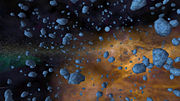 Meadville Ice Asteroid Field |
Scranton Asteroid Field
Location: B/7
- A medium-sized field of rock asteroids. Barely explored, this field is located in one of the most remote regions of Pennsylvania and often serves as a hideout for Rogues and other dangerous criminals chased by Bounty Hunters or Police patrols.
|
|
Driftwood Ice Asteroid Field
Location: G/6
- A large field of ice asteroids on the outskirts of the Pennsylvania system. Xeno activity is significant within the field.
|
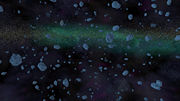 Driftwood Ice Asteroid Field |
Wilkes-Barre Asteroid Field
Location: E/2
- A desolate medium-sized rock asteroid field. Traces of valuable metals have been found by initial surveys conducted by Zoners, but no further research has been made due to increasing pirate activity in the Pennsylvania system.
|
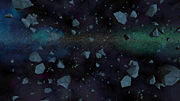 Wilkes-Barre Asteroid Field |
Mineable Commodities
Water
Location: G/6, D/6
- Dihydrogen monoxide (H2O) is odorless, tasteless, transparent, and absolutely essential to human life. Roughly 75% of the human body is composed of Water. Deprived of Water, most humans can only live three days. The process of dehydration is a painful one, as tissues shrivel and vessels shrink in a desperate bid by the dying body to preserve its remaining vital functions.
Helium
Location: F/3
- Helium is a colorless, odorless, tasteless, non-toxic, inert monatomic chemical element that heads the noble gas group in the periodic table and whose atomic number is 2. Its boiling and melting points are the lowest among the elements and it exists only as a gas except in extreme conditions. Accumulated in a number of ice asteroid fields around Sirius, helium is required for a number of industries along with neon, and is mined in small to medium quantities by independent suppliers.
Hydrocarbons
Location: C/3
- Hydrocarbons are a class of organic compounds composed only of hydrogen and carbon molecules, resulting in a wide variety of substances that have important industrial applications. While hydrocarbons naturally occur in a gaseous state almost everywhere in the known universe, frozen deposits present the most easily exploited form of the substance. Hydrocarbon mining is key to the industrialization of the Sirius Sector as it provides the raw materials for the creation of the Ship Hull Panels and Optronics, upon which modern society depends.
Silver Ore
Location: E/2
- Ore is a type of rock that contains minerals such as metals which can be extracted through mining and refined for use. The ores must be processed to extract the metals of interest from the waste rock and from the ore minerals. Many organizations prefer to receive unsmelted ores in order to keep the additional cost of their production and finish within the local economy, as opposed to paying markups to foreign laborers to do the work for them.
Platinum Ore
Location: E/5
- Ore is a type of rock that contains minerals such as metals which can be extracted through mining and refined for use. The ores must be processed to extract the metals of interest from the waste rock and from the ore minerals. Many organizations prefer to receive unsmelted ores in order to keep the additional cost of their production and finish within the local economy, as opposed to paying markups to foreign laborers to do the work for them.
![]() Liberty]]
Liberty]]
